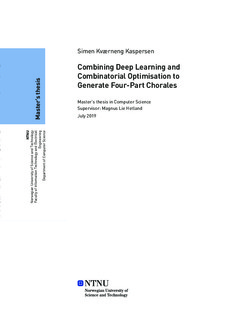| dc.contributor.advisor | Hetland, Magnus Lie | |
| dc.contributor.advisor | Brandtsegg, Øyvind | |
| dc.contributor.author | Kaspersen, Simen Kværneng | |
| dc.date.accessioned | 2019-11-06T15:03:38Z | |
| dc.date.available | 2019-11-06T15:03:38Z | |
| dc.date.issued | 2019 | |
| dc.identifier.uri | http://hdl.handle.net/11250/2627021 | |
| dc.description.abstract | Denne masteroppgaven beskriver implementasjonen av en funksjonell prototype som består av
et rekurrent neuralt nettverk og en branch-and-bound optimeringsalgoritme i konjunksjon for å
generere musikk som tilretter seg reglene for firstemmig korallsats i Bach-stil.
Den eksakte naturen til musikk generert av neurale nettverk er vanskelig å forutse, og derfor
også å manipulere på noen som helst meningsfull måte mellom input og output. Hvor godt resultatene
gjenspeiler de mer abstrakte aspektene av musikk er vanskelig å kontrollere, og ofte viser de
lite eller ingen musikalsk struktur eller kreativitet. I tillegg er det få innfallsvinkler for interaksjon
og inngripen når man benytter seg av et slikt "svart boks"-system. Denne oppgaven utforsker måter
å imøtekomme disse utfordringene på fra utsiden, og viser at kombinatoriske optimeringsstrategier
kan benyttes i etterkant til å påføre musikalske rammer og endre output slik at den innfinner seg
konvensjonene og forventningene til vestlig musikkteori. De nye resultatene demonstrerer en stor
forbedring i funksjonell struktur, melodisk og harmonisk utvikling og estetikk sammenlignet med fra
før. Selv om prototypen ikke var i stand til å finne optimale transformasjoner fra neuralnettverkets
output innenfor rimelig tid, ble det demonstrert en metode som finner lavkostnadskombinasjoner
med gyldig struktur som kan benyttes til å generere resultater som demonstrerer programmets
funksjon. | |
| dc.description.abstract | This thesis describes the implementation of a functional prototype consisting of a recurrent neural
network and a branch-and-bound optimiser which together generate original music compliant to
the rigid rule-set of the four-part chorale in the style of Johann Sebastian Bach.
The exact nature of music generated by neural networks is troublesome to predict, and by extension
to manipulate in any meaningful way between input and output. How well the results adhere to
the more abstract aspects of music is hard to control, and often display little to no musical structure
or significant creativity. Also, there are few avenues for interactivity and active intervention in the
usage of such a "black-box" system. The paper explores means to mitigate this externally, and shows
that combinatorial optimisation strategies can be employed post-generation to enforce musical constraints
and adjust the output in such a way that it adheres to the conventions and expectations of
western music theory. The constrained results display significant improvement in functional structure,
melodic and harmonic progression and aesthetics compared to those generated by the neural
network alone. Although the prototype is not capable of locating optimal transformations from the
neural network output within reasonable time, a method for finding low cost chord combinations
with valid structure can be used to generate results that demonstrate the applications of the system. | |
| dc.language | eng | |
| dc.publisher | NTNU | |
| dc.title | Combining Deep Learning and Combinatorial Optimisation to Generate Four-Part Chorales | |
| dc.type | Master thesis | |
